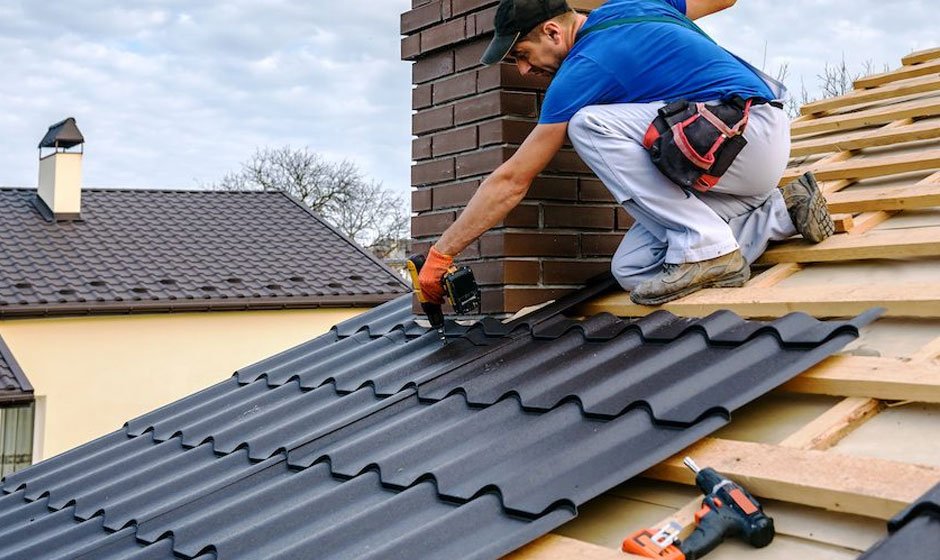Discover the Sustainable Benefits of Metal Roofing for Your Home

Environmental consciousness shapes modern living. Homeowners seek sustainable solutions. Metal roofing has emerged as a pioneering eco-friendly choice. It offers multiple benefits beyond mere functionality. This exploration delves into how metal roofing champions sustainability. From energy efficiency to recyclability and climate change mitigation, it empowers homeowners. They can make an informed decision aligned with eco-conscious values.
Harnessing Energy Efficiency
Metal roofing boasts remarkable energy efficiency. Traditional asphalt shingles absorb and trap heat. Metal surfaces deflect a substantial amount of solar energy. This reduces heat absorption in your home. It leads to lower cooling costs and decreased energy consumption. A harmonious union with nature’s resources is achieved.
Specialized cool roof coatings enhance reflective properties. They increase the solar reflectance index (SRI) to 0.9, reflecting 90% of the sun’s energy. The coatings reflect sunlight and release absorbed heat. They significantly reduce heat transfer to your home’s interior. The coatings minimize the need for air conditioning and promote natural cooling. The coatings merge energy efficiency and environmental stewardship. A skilled metal roof installation contractor can ensure the proper application of these coatings to maximize the energy-saving benefits of your metal roof.
Longevity
Metal roofing solutions have renowned exceptional longevity and durability. Traditional roofing materials require replacement every 15–20 years. High-quality metal roofing can endure for 50 years or more with proper care. This extended lifespan significantly reduces replacement frequency. The environmental impact of producing, transporting, and disposing of roofing materials is minimized. Longevity and resource conservation harmonize.
Metal roofing exhibits superior resilience against harsh elements. High winds, heavy rain, hail, and wildfires are withstood. Your home is well-protected for decades. Frequent repairs are minimized. Environmental sustainability is further contributed to. Protection and ecological stewardship find balance.
Recyclability
Metal roofing is inherently recyclable. This aligns with the circular economy’s virtuous cycle. Steel, aluminum, and copper can be recycled indefinitely without property loss. When a metal roof reaches its lifespan end, it transforms into new products. Landfill waste is prevented. The waste crisis is not contributed to.
Recycling metal roofing reduces waste. It conserves Earth’s finite resources. It minimizes the need for extracting new raw materials. Likewise, it significantly reduces the roofing industry’s environmental impact. Recycling keeps materials in use for as long as possible. It minimizes waste and promotes sustainability. Recycling harmonizes renewal and regeneration.
Climate Change Mitigation
Metal roofing mitigates climate change effects by reducing energy consumption and carbon emissions. Its high reflectivity minimizes the urban heat island effect. Urban areas experience higher temperatures due to heat absorption by traditional roofing materials. Metal roofing reflects solar radiation. It contributes to lowering ambient temperatures in urban environments. The energy demand for cooling and associated greenhouse gas emissions are reduced. A proactive stance against climate change is taken.
Metal roofing offers superior resilience against increasing extreme weather events caused by climate change. It withstands high winds, heavy rainfall, and hail storms. The risk of damage and the need for frequent replacements are minimized. Homeowners gain peace of mind and long-term financial savings. Metal roofing contributes to climate change mitigation and prepares homes for the challenges ahead. Environmental stewardship and practical preparedness balance.
Aesthetic Appeal and Environmental Harmony
Sustainability is crucial, but metal roofing also offers aesthetic appeal. It seamlessly integrates into your home’s overall design. A wide range of colours, styles, and finishes are available. Metal roofing complements various architectural styles, from contemporary to traditional. You can express your unique taste while embracing eco-conscious living.
Many manufacturers offer options mimicking other roofing materials like shingles or tiles. Homeowners enjoy durability and aesthetics while maintaining environmental harmony. Metal roofing creates visually stunning and environmentally responsible homes. Beauty and sustainability fuse harmoniously.
Value in the Long Haul
Metal roofing may seem expensive upfront compared to other options. However, consider the long-term value and environmental impact. The real advantage lies in durability, energy efficiency, and low maintenance requirements. These roofing systems reduce cooling costs and rarely need replacement. The initial cost is offset over time, and frequent replacements’ environmental toll is minimized.
Homeowners may qualify for tax breaks or rebates for choosing eco-friendly roofing. Metal roofing becomes even more cost-effective. Investing in metal roofing contributes to environmental conservation while enjoying substantial long-term savings. Eco-consciousness and financial prudence converge harmoniously.
Conclusion
As sustainable construction practices gain importance, metal roofing stands out. It is a smart choice for eco-conscious homeowners seeking environmentally-friendly and cost-effective solutions. Energy savings, durability, recyclability, climate change mitigation, and minimal environmental impact are excelled at. Metal roofing offers a comprehensive eco-conscious living package. Sustainability and functionality harmonize.
Embracing metal roofing means contributing to environmental conservation while enjoying reduced utility bills, low repair costs, superior home protection, and enhanced aesthetic appeal. It represents a harmonious integration of eco-conscious values and practical living. A testament to sustainable choices shaping a greener future.
Embark on your eco-conscious living journey. Explore the world of metal roofing. Make a choice benefiting your home and the planet. Together, we can create a sustainable future, one roof at a time. Environmental stewardship and responsible living will harmonize.



![How to Make Your Home Office Comfortable in Any Season [Image Source] Working from home has become the new normal for many people. Whether it’s full-time or just a few days each week, a lot of us have turned spare bedrooms, garages, or corners of the living room into offices. While setting up a work-from-home space is easy in theory, making it a place you actually want to spend time in takes a little more thought. Comfort goes beyond a desk and a chair. It’s about lighting, temperature, air quality, and the overall feel of the space. When the room is too hot in the summer or freezing in the winter, it’s hard to stay focused. The wrong setup can leave you distracted, tired, and less productive. In this article, you’ll learn how to create a home office that feels comfortable no matter the season. These tips don’t require a complete renovation or a huge budget. They’re practical changes you can make now to upgrade your space and feel better throughout your workday. Choose the Right Heating and Cooling Setup Temperature plays a big role in how comfortable your office feels. If you’ve ever worked in a room that doesn’t stay warm in the winter or cool in the summer, you know how distracting that can be. A small change in temperature can affect your mood, focus, and even how your body feels after sitting for hours. Some home offices are in places that weren’t originally meant for year-round use—like finished basements, sunrooms, or attic spaces. These rooms often don’t get enough airflow from your home’s main heating and cooling system. That leads to hot spots in summer and cold zones in winter, which can make working from home feel like a chore. One way to handle this is by installing ductless mini-split systems. These allow you to control the climate in just one room without relying on your main HVAC system. They’re energy-efficient, easy to install in finished or unfinished spaces, and perfect for areas where running new ductwork isn't ideal. With a mini-split system, you can heat or cool your office independently from the rest of the house. That means you won’t waste energy adjusting the entire home just to stay comfortable during work hours. If you like your office cooler than the rest of the house—or if you’re using a room that’s always too hot—this gives you full control. These systems are also quiet, which helps if you're on video calls or need to concentrate without background noise. Instead of noisy window units or floor heaters, you get clean, steady temperature control without the hum or rattle. When your office stays at the right temperature all day, you’re more likely to stay focused, feel better, and get more done. Maximize Natural Light and Supplement Wisely Natural light can help you feel more alert and focused throughout the day. If possible, place your desk near a window. Morning sunlight boosts mood and energy, and exposure to natural light during the day can support better sleep at night. That said, natural light isn't always available—cloudy days, early mornings, or late evenings can make your office feel dim. Supplement with good-quality LED lighting. A desk lamp with adjustable brightness can help reduce eye strain. You can also add soft overhead lights for a balanced look that isn’t too harsh. Layering your lighting makes the space feel more comfortable. Combine ambient lighting with focused task lighting to create the right balance between visibility and relaxation. Use Smart Window Coverings Your windows play a big part in how well your office stays warm in the winter and cool in the summer. The right window coverings help block out heat during hot months and hold in warmth during colder ones. Blackout curtains or thermal blinds are a great choice for year-round comfort. In summer, they help keep the room from overheating during the day. In winter, they act as an extra barrier between your office and the cold air outside. Light-filtering shades are another option if you want to keep things bright while still reducing glare and heat. These coverings help manage indoor temperature without making the room feel closed off or dark. Add Functional Comfort Items Comfort doesn’t stop at temperature. The furniture and accessories you choose also affect how your body feels after hours at your desk. Start with your chair. It should support your back, allow your feet to rest flat on the floor, and adjust to your height. You don’t need a luxury brand—just something that helps you sit comfortably for long periods. A footrest can also help you relax your legs and improve posture. Placing a soft rug under your desk adds warmth and padding, which helps in both cold and hot seasons. Think about wrist support, desk height, and screen position. Small accessories like a keyboard tray or monitor stand can help reduce strain on your neck and shoulders. The goal is to stay comfortable without feeling stiff or sore by the end of the day. Improve Air Quality and Humidity Control Air quality plays a huge role in comfort and health. If your home office feels stuffy or stale, you might need to improve air circulation. A small air purifier can help reduce dust, pet dander, or allergens, especially useful in closed-off spaces. In winter, the air tends to get dry, which can cause dry skin, throat irritation, or even static shocks. A humidifier adds moisture to the air and helps you breathe better. In summer, excess humidity can make the room feel sticky and uncomfortable. In that case, a dehumidifier helps keep things in balance. Clean air and proper humidity levels support better focus and overall well-being, which makes your workday more productive. Keep Distractions Low with Sound Control Noise distractions can break your concentration fast. If your home office is near a busy street, a loud TV, or shared walls, you might need to block out sound. Start by adding soft materials like rugs, curtains, or fabric wall panels. These help absorb sound and reduce echo. You can also use a white noise machine or a fan to mask background noise during meetings or focus sessions. For windows and doors, add draft blockers or weather stripping to limit sound coming from outside. If you use video calls often, having a quiet space helps you speak and hear more clearly. A comfortable home office helps you work better through every season. With the right setup, you can stay focused and feel good during long hours at your desk. From smart heating and cooling to better lighting and air, small changes go a long way. Create a space that supports your goals—one that works for you all year.](https://lucykingdom.com/wp-content/uploads/2025/05/How-to-Make-Your-Home-Office-Comfortable-in-Any-Season-600x357.jpg)